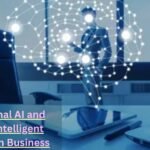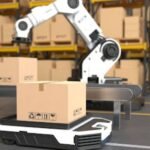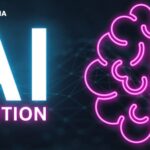The smartest investment any company can make today is in technology that truly helps the people who work there. By using tools that can predict things and automate tasks, the smart use of AI in HR is no longer a choice. It is a necessary tool for all the best companies.
Experts are predicting that artificial intelligence in human resources will be a part of over 80% of organizations very soon. This will completely change how we hire, train, and keep talented employees. Plus, companies that use AI in HR are 40% more likely to have higher employee engagement scores.
This huge change allows HR leaders to stop sorting through paper and start focusing on serious business strategy. I’m writing this guide as I have watched these systems change workplaces, explaining the practical uses of AI.
By reading our article you will discover how AI for human resources boosts productivity, makes decision-making better, and creates a much smoother experience for every single employee.
Key Takeaways
- Saves Big Time: AI handles tasks like resume screening and scheduling automatically. This can cut the time needed to hire someone by as much as 50%.
- Hiring Smarter: When programmed correctly, AI helps reduce unfairness in candidate screening by up to 50%. This leads to better, more diverse hiring.
- Stay Ethical: HR leaders must always make data privacy a top priority. They must constantly check algorithms to prevent unfair bias.
- The Agents Are Coming: The biggest trend on the way is Agentic AI. It will handle complex, multi-step HR processes completely on its own.
What Does AI in HR Really Mean?
AI in HR means we are using smart computer systems, like machine learning (ML) and complex algorithms, to automate the boring, routine tasks. It also helps us pull deep, useful facts from HR data. This is much more advanced than just simple computer programs.
The AI models learn from the company’s history. They look at data about employees who performed well, how long people stayed at the job, and internal career moves. Because the systems learn, they get much better at seeing what the company will need in the future. They can predict staff shortages or spot early signs of employee burnout before it’s too late.
HR teams today use three main types of AI:
- Generative AI: This type creates new content very quickly. For example, it can draft clear job descriptions or summarize long company policy updates for managers.
- Natural Language Processing (NLP): This is how the system understands human words. It is vital for quickly reading and summarizing thousands of resumes or analyzing the open comments in an employee survey.
- Predictive Analytics: This is the tool that forecasts the future. It uses current employee data to predict outcomes. For instance, it can guess which employees are most likely to leave the company in the next six months.
How AI Is Being Used Across HR Functions
AI for HR professionals is changing every major job. It makes processes faster, fairer, and often much more personal for the employee.
Talent Acquisition and Recruiting
Recruitment is where AI for HR gives the fastest and biggest results. The old hiring process was slow and expensive, but AI handles the heavy lifting instantly.
AI platforms can instantly sort through huge piles of resumes. They filter candidates based only on skills and job requirements. This saves recruiters countless hours of manual review. As a result, 40% of organizations already use AI for recruitment and talent acquisition.
The algorithms do more than just match keywords. They look at data from past employees who performed well in a specific job. This helps them find the candidates who are truly the most likely to succeed in that role.
AI-powered chatbots answer common questions from candidates about the job, benefits, and application status instantly. This gives candidates a great experience 24 hours a day, making the company look modern and efficient.
When you automate the initial tasks like screening and interview scheduling, human recruiters gain huge amounts of time. My advice is simple: let the machines handle the data so the humans can build great relationships with the top talent.
Learning & Development
Training used to be the same generic presentation for everyone. Now, AI in human resources is making learning personal and highly focused.
The AI analyzes data on an employee’s current performance, what skills they lack, and where they want their career to go. Then, it recommends specific training, courses, and materials that fit their individual needs. This is a much more efficient way to train staff. This targeted approach ensures that the company’s training dollars are spent wisely.
Performance Management
Performance reviews were often stressful, slow, and relied too much on a manager’s personal feelings. AI human resources tools are making the process more objective and continuous.
AI systems track employee data and feedback constantly, not just once a year. This gives managers objective, real-time insights into performance trends. This shift away from annual ratings to continuous feedback, supported by clear data, fosters a much healthier growth culture. In fact, using AI helps reduce bias in performance reviews by 25% across various industries.
Employee Engagement & Experience
A great employee experience is the best way to keep your staff. AI for human resources provides personalized support at a massive scale.
AI virtual assistants instantly answer common questions about vacation time, benefits, and company policy. This makes employees feel supported and takes huge pressure off the HR help desk.
The AI tools also analyze text from employee surveys and team communication. They can quickly figure out how people are really feeling. This identifies potential problems like low morale or team burnout before they turn into major turnover issues.
HR Operations and Administration
Getting rid of boring, repetitive tasks is where AI in HR management creates huge gains in speed and accuracy.
Technologies like Robotic Process Automation (RPA) handle data entry, payroll processing, and compliance checks automatically. This automation minimizes human error. Think about payroll: AI-driven systems are expected to reduce payroll errors by up to 90% by 2025. This makes the entire HR department more reliable and much more efficient.
Major Benefits of AI for HR Leaders
HR leaders are quickly realizing that the benefits of artificial intelligence in human resources have a direct impact on the company’s finances.
| Benefit | Description | Key Result |
| Efficiency Boost | Automates data entry and screening. | Frees up 40% of HR team time for strategic tasks. |
| Quality Hiring | Predictive data identifies best-fit candidates. | Improves the quality of new hires and reduces costly mis-hires. |
| High Retention | Predicts which employees might be thinking of leaving. | Allows managers to intervene proactively and retain top talent. |
| Fairness | Screens based on objective skills and qualifications. | Promotes a more diverse and inclusive hiring process. |
By letting the AI handle administrative work, HR professionals can shift their focus entirely to strategic work. This means spending time on organizational change, improving company culture, and planning talent development that perfectly matches the company’s future needs.
AI Tools and Platforms HR Professionals Use
AI tools for HR are not all separate programs. Many are now built right into the major systems HR already uses, like Applicant Tracking Systems (ATS) and HR Information Systems (HRIS).
- AI-Enhanced ATS: These use machine learning to automatically score and rank candidates based on detailed job requirements.
- HR Self-Service Chatbots: Provide instant support for employees asking basic policy questions.
- Internal Talent Marketplaces: These platforms use AI to match current employees with internal jobs or mentors based on their skills. This is vital for encouraging internal career growth.
- Predictive Analytics: Specialized software tracks employee data to forecast things like turnover risks and where the company will have skill shortages next year.
Challenges and Risks of Implementing AI in HR
Implementing AI in HR is not easy. HR leaders must move forward very carefully and ethically, as there are serious risks.
The biggest danger is algorithmic bias. If the data used to train the AI (like old hiring records) contains human prejudices, the AI will learn and repeat that unfairness. For example, a few years ago, Amazon had to shut down an AI tool that was biased against women because it learned from male-dominated historical resumes. HR must audit its algorithms constantly to ensure fairness.
There are other major challenges too:
- Privacy Rules: AI uses huge amounts of sensitive employee data. Strict compliance with global privacy laws, like GDPR, is incredibly complex and important.
- Lack of Trust: Employees may not trust the “black box” decisions made by AI, especially if it affects their performance review or career. Clear communication and human oversight for final decisions are essential to build trust.
- The Skills Gap: HR teams need new training. They must become experts in data literacy and ethics to manage these AI-augmented teams effectively.
Real-World Examples: How Leading Organizations Use AI in HR
Seeing how top companies use these tools makes the benefits very clear:
- Starbucks: They use AI for hr through their “Deep Brew” app to automate complex labor scheduling. The AI predicts the exact staffing needed based on sales data, foot traffic, and seasonal trends. This ensures there are always enough staff to serve customers without unnecessary labor costs.
- Unilever: This global company put AI at the start of its recruitment process. They used AI to screen hundreds of thousands of applications and video interviews quickly. This helped them find a much more diverse group of candidates faster than traditional methods.
- Zillow Group: They used AI tools to review their job descriptions and remove any potentially biased language. After using the AI, they reported a 12% increase in the number of women applying for their jobs. This shows how AI can directly improve diversity.
Future Trends: What’s Next for AI in HR
The future of AI in HR is rapidly moving past simple chatbots toward greater autonomy and strategic planning.
The biggest trend coming is the rise of Agentic AI. This AI system does not just wait for a command. It can plan, act, and complete full, multi-step HR processes on its own. Imagine an AI agent fully handling a complex employee leave request—updating payroll, notifying managers, and sending required compliance documents—all with minimal human input. This next generation of AI human resources promises massive scalability.
Another major focus is on building dynamic skills inventories. Companies are using AI to constantly assess the current skills of their entire staff. They compare this to the skills the company will need in the next five years. This allows HR to proactively launch training programs or reskilling efforts to close that gap and future-proof the workforce.
How HR Leaders Can Get Started with AI
You do not need a huge budget or an IT overhaul to begin. You can start small to prove the value of AI in HR management:
- Find Your Biggest Pain: Start by targeting one workflow that is manual and takes up too much time. Interview scheduling or initial resume screening are perfect places to start.
- Pilot a Self-Service Tool: Introduce a simple AI chatbot for employees to ask basic policy questions. This immediately reduces the number of tickets your HR team has to answer every day.
- Establish Ethical Rules: Before using AI for hiring or performance, set up clear guidelines. Always ensure human review for final decisions, and be completely transparent with employees about how their data is being used.
- Boost Data Skills: Train your HR team on data literacy. They do not need to be coders, but they must understand how to use AI in HR by correctly interpreting the data. The best results happen when AI efficiency meets human judgment and empathy.
Conclusion
The evolution of HR is not about replacing people with technology. It is about using the power of artificial intelligence in human resources to free up skilled professionals from repetitive work. This empowers HR leaders with predictive data to make smarter, fairer, and faster decisions about a company’s most valuable asset: its employees. By adopting these powerful tools thoughtfully, HR becomes a truly strategic force that drives productivity and organizational success.
Frequently Asked Questions (FAQs)
What is Agentic AI in human resources?
Agentic AI is an advanced computer system that can think, plan, and carry out several steps of an HR task all by itself. For example, it could handle an employee’s full relocation process, including document updates and necessary approvals, with very little human help.
How does AI help reduce bias in hiring?
AI systems help reduce bias by focusing only on objective facts. They screen and score candidates based purely on skills and job requirements. This often hides personal details like names or addresses from recruiters to ensure a fairer process.
Can AI predict when an employee might leave the company?
Yes. Predictive analytics uses machine learning to look at patterns in employee data, such as engagement scores and team communication. It flags employees who show patterns linked to high turnover risk so HR can step in and offer support.
What are the main benefits of AI in HR for large companies?
The main benefits are huge gains in efficiency for recruitment, which can cut time-to-hire by 50%. It also improves employee retention by identifying those at risk of leaving, which saves significant replacement and training costs.
What is the biggest ethical challenge when using AI in HR?
The biggest ethical challenge is algorithmic bias. If the data used to train the AI is already unfair (like past hiring records), the AI will learn and repeat that discrimination, leading to unfair outcomes in hiring or performance reviews.
Sources & References
- https://www.nu.edu/blog/ai-statistics-trends/ (National University, AI Statistics and Trends)
- https://hirebee.ai/blog/ai-in-hr-statistics/ (Hirebee.ai, AI in HR Statistics)
- https://www.apollotechnical.com/surprising-statistics-on-ai-in-the-workplace/ (Apollo Technical, Surprising Statistics on AI in the Workplace)
- https://www.shrm.org/topics-tools/research/2025-talent-trends/ai-in-hr (SHRM, The Role of AI in HR Continues to Expand)
- https://www.paradigmiq.com/blog/ai-in-hr-examples/ (ParadigmIQ, 6 Real-World AI in HR Examples: Drive Performance)
- https://www.teamsense.com/blog/examples-ai-in-hr (TeamSense, 11 Real World Examples of AI in HR Driving Success)
- https://www.adp.com/spark/articles/2025/11/top-6-hr-trends-to-follow-in-2026.aspx (ADP, Top 6 HR Trends to Follow in 2025)
- https://www.mckinsey.com/capabilities/quantumblack/our-insights/the-state-of-ai (McKinsey, The state of AI in 2025: Agents, innovation, and transformation)









